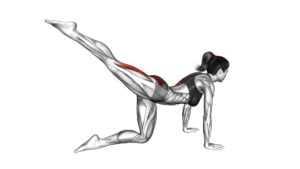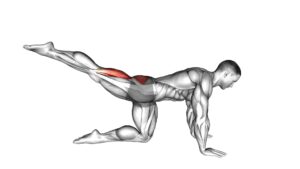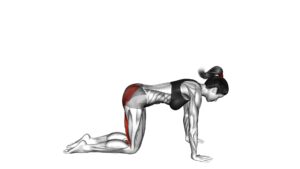Kneeling Straight Leg Kickback (VERSION 2) (left) – Video Exercise Guide & Tips

Are you looking to tone and strengthen your left leg muscles? Look no further than the Kneeling Straight Leg Kickback (Version 2).
Watch This Exercise Video
In this video exercise guide, we'll show you the proper setup and starting position, along with a step-by-step guide for performing the exercise.
We'll also highlight common mistakes to avoid and share tips for maximizing the effectiveness of this workout.
Get ready to kick your fitness goals into high gear!
Key Takeaways
- Kneeling straight leg kickback targets and strengthens the glute muscles while engaging the core.
- Proper setup and alignment are crucial to maintain stability and effectiveness during the exercise.
- Variations such as using ankle weights or a resistance band can increase the intensity of the exercise.
- Gradually progressing and adjusting resistance based on individual fitness level and goals is important to avoid injury and ensure proper form.
Benefits of the Kneeling Straight Leg Kickback (left)
You can experience increased glute activation and improved hip mobility through the kneeling straight leg kickback (left). This exercise is great for maximizing results because it specifically targets the glute muscles while also engaging the core. By performing this movement, you can strengthen and tone your glutes, leading to improved overall lower body strength and stability.
To perform the kneeling straight leg kickback (left), start by kneeling on all fours with your hands directly under your shoulders and your knees under your hips. Extend your left leg straight back, keeping it in line with your body. Engage your glutes and lift your leg upwards, squeezing the glute muscles at the top of the movement. Slowly lower your leg back down to the starting position and repeat for the desired number of repetitions.
There are variations and modifications you can incorporate to increase the intensity or target different muscles. For example, you can add ankle weights to increase resistance or perform the kickback on a stability ball to challenge your balance. Additionally, you can try the exercise with a resistance band wrapped around your thighs to engage your outer glutes even more.
Remember to engage your core throughout the movement and maintain proper form to maximize the benefits of the kneeling straight leg kickback (left).
Equipment Needed for the Exercise
To perform the Kneeling Straight Leg Kickback exercise, you'll need some necessary equipment.
These essential exercise tools include:
- A yoga mat or a soft surface to kneel on
- A resistance band or ankle weights to add resistance to the movement
Additionally, it's important to wear comfortable workout gear that allows for a full range of motion and provides sufficient support during the exercise.
Necessary Equipment for Exercise
To perform the Kneeling Straight Leg Kickback (VERSION 2) (left), you'll need the following equipment:
- Exercise Mat: A comfortable and non-slip mat provides cushioning and support during the exercise.
- Resistance Band: Using a resistance band adds resistance to the kickback movement, intensifying the workout.
- Optional Ankle Weights: Ankle weights can be used to further challenge your muscles and increase the difficulty of the exercise.
Wearing appropriate workout attire is also important to ensure comfort and ease of movement during the Kneeling Straight Leg Kickback (VERSION 2) (left). Choose clothing that allows for unrestricted movement and proper ventilation.
Additionally, if you have any specific exercise modifications or adaptations, such as using a stability ball instead of a mat, make sure you have the necessary equipment for those modifications. Remember to always listen to your body and make adjustments as needed to ensure a safe and effective workout.
Essential Exercise Tools
To perform the Kneeling Straight Leg Kickback (VERSION 2) (left) effectively, ensure you have the essential exercise tools. This exercise doesn't require any specific equipment, making it a convenient option for home workouts or when you don't have access to a gym. All you need is a comfortable mat or cushion to kneel on to protect your knees.
Additionally, you may use ankle weights or resistance bands to add intensity to the exercise and increase muscle activation. These tools can help you challenge your glutes and hamstrings further, making the workout more effective.
Experimenting with different exercise variations and using the appropriate equipment will allow you to target specific muscle groups and achieve your fitness goals efficiently.
Required Workout Gear
To effectively perform the Kneeling Straight Leg Kickback (VERSION 2) (left), you'll need specific workout gear and equipment.
Here are the essential items you'll need:
- Workout Attire: Wear comfortable and breathable clothing that allows for a full range of motion. Opt for moisture-wicking fabrics to keep you dry during the exercise.
- Exercise Mat: Use a cushioned mat to provide support and protect your knees during the kneeling position. It helps prevent discomfort and potential injuries.
- Ankle Weights: These weights can be strapped around your ankles to add resistance and intensify the exercise. Start with lighter weights and gradually increase as you become more comfortable.
Having the right workout attire and exercise equipment is crucial for performing the Kneeling Straight Leg Kickback (VERSION 2) (left) effectively and safely. Make sure to wear appropriate clothing and use the necessary equipment to maximize the benefits of this exercise.
Proper Setup and Starting Position
To ensure proper form and alignment during the kneeling straight leg kickback exercise, there are a few key points to keep in mind.
First, make sure your hands are directly under your shoulders and your knees are directly under your hips.
Engage your core and keep your back straight throughout the movement.
Additionally, be mindful of avoiding common mistakes such as arching your back or lifting your leg too high, as this can compromise the effectiveness of the exercise.
Correct Form and Alignment
Start by positioning your body correctly and establishing the proper setup and starting position for the kneeling straight leg kickback exercise. This will ensure that you perform the exercise with proper technique and avoid common errors. Here's how to do it:
- Kneel down on all fours, with your hands directly under your shoulders and your knees directly under your hips.
- Extend your left leg straight out behind you, keeping your knee straight and your toes pointed.
- Engage your core muscles to maintain a stable and neutral spine throughout the exercise.
Avoiding Common Mistakes
Maintain proper form and alignment for the kneeling straight leg kickback exercise by ensuring a stable and neutral spine while extending your left leg straight out behind you. Avoid common mistakes that can hinder your progress and potentially lead to injury.
One common misconception about the kneeling straight leg kickback is that lifting your leg higher will yield better results. However, it's important to focus on controlled and deliberate movements rather than excessive height.
Another mistake to avoid is arching your back or rounding your shoulders during the exercise. Keep your core engaged and maintain a straight line from your head to your extended leg.
To modify the kneeling straight leg kickback for different fitness levels, you can decrease or increase the range of motion based on your abilities. Start with smaller kicks and gradually increase the height as you build strength and flexibility.
Always listen to your body and make adjustments as needed to ensure a safe and effective workout.
Step-By-Step Guide to Performing the Exercise
Once you have positioned yourself in a kneeling position, begin the exercise by extending your left leg straight back behind you.
To perform the Kneeling Straight Leg Kickback (Version 2) (left) correctly, follow these step-by-step instructions:
- Start in a kneeling position with your hands on the ground, shoulder-width apart.
- Engage your core and keep your spine neutral throughout the exercise.
- Extend your left leg straight back, keeping it in line with your body.
- Squeeze your glutes as you lift your left leg as high as you can without compromising your form.
- Pause for a moment at the top of the movement, feeling the contraction in your glutes.
- Slowly lower your leg back down to the starting position.
- Repeat for the desired number of repetitions, then switch sides.
Variations and modifications:
- If you find it challenging to balance, place a stability ball or yoga block under your hands for support.
- To increase the intensity, add ankle weights or use a resistance band around your ankles.
- If kneeling is uncomfortable, you can perform the exercise while standing, using a chair or wall for support.
Remember to listen to your body and start with a weight and difficulty level that suits your fitness level.
Common Mistakes to Avoid While Doing the Kickback
To avoid common mistakes while performing the Kneeling Straight Leg Kickback (Version 2) (left), it's important that you maintain proper form and technique. One common mistake to avoid is arching your back during the exercise. This can put unnecessary strain on your lower back and reduce the effectiveness of the kickback. Instead, focus on keeping your back straight and engage your core muscles to stabilize your body.
Another mistake to avoid is lifting your leg too high or too quickly. While it may be tempting to lift your leg as high as possible, it's important to remember that the goal is to engage your glutes and not just lift your leg. Lift your leg in a controlled manner, making sure to squeeze your glutes at the top of the movement.
Lastly, avoid swinging your leg or using momentum to perform the kickback. This can take the focus away from your glutes and place strain on other muscles. Instead, focus on using your glutes to lift and extend your leg, keeping the movement slow and controlled throughout.
Tips for Maximizing the Effectiveness of the Kickback
For optimal effectiveness of the kickback, focus on engaging your glutes throughout the exercise and avoid relying on momentum or swinging your leg. By following these tips, you can maximize muscle activation and get the most out of your workout.
Here are some additional tips to help you maximize the effectiveness of the kickback:
- Maintain proper form: Keep your back straight and your core engaged throughout the exercise. This will help you target your glutes and prevent strain on your lower back.
- Control your movement: Slowly extend your leg back while keeping your knee bent at a 90-degree angle. Avoid jerking or swinging your leg, as this can reduce the effectiveness of the exercise.
- Adjust the resistance: Use ankle weights or resistance bands to add extra resistance and challenge your muscles. Start with a lighter resistance and gradually increase as you get stronger.
Variations for different fitness levels:
- Beginners: Start with a kneeling kickback without any added resistance. Focus on mastering the movement and engaging your glutes before progressing to more challenging variations.
- Intermediate: Add ankle weights or resistance bands to increase the intensity of the exercise. This will help you build strength and muscle definition in your glutes.
- Advanced: Incorporate single-leg kickbacks or try the exercise on a stability ball to further challenge your balance and stability while targeting your glutes.
Frequently Asked Questions
How Many Calories Does the Kneeling Straight Leg Kickback (Left) Burn?
The kneeling straight leg kickback (left) is a great exercise for improving flexibility and toning your glutes.
While the exact number of calories burned during this exercise can vary based on factors like intensity and duration, it's generally considered a moderate calorie-burning activity.
To add variety to your workouts, you can also try different variations of the kneeling straight leg kickback, such as using resistance bands or ankle weights.
Remember to always listen to your body and consult a professional if needed.
Can the Kneeling Straight Leg Kickback (Left) Help Improve Balance?
The kneeling straight leg kickback (left) can help improve your balance and stability. By engaging your core and working on your leg strength, this exercise challenges your body to maintain stability while performing the movement.
Additionally, there are alternative variations of this exercise that can further enhance your balance. Incorporating it into your workout routine can be beneficial for improving overall stability and balance.
Is It Normal to Feel a Stretch in the Hip Flexors During the Exercise?
During the kneeling straight leg kickback exercise, it's normal to feel a stretch in your hip flexors. This is because the movement involves activating the hip flexor muscles.
The stretch sensations in your hip flexors indicate that these muscles are being engaged and stretched during the exercise. It's important to listen to your body and make sure you aren't pushing yourself too far to avoid any discomfort or injury.
Can the Kneeling Straight Leg Kickback (Left) Help Strengthen the Core?
Yes, the kneeling straight leg kickback (left) can help strengthen your core. This exercise targets your glutes and hamstrings while also engaging your core muscles for stability.
By performing this movement, you aren't only working on your lower body strength but also improving your core stability.
If you're looking for alternative exercises to strengthen your core, you can try planks, Russian twists, or bicycle crunches.
How Often Should the Kneeling Straight Leg Kickback (Left) Be Performed for Best Results?
To achieve the best results, you should perform the kneeling straight leg kickback (left) regularly. Aim for at least three times a week, allowing for rest days in between to give your muscles time to recover.
Consistency is key, so try to stick to a schedule that works for you. Remember that this exercise not only strengthens your core but also offers other benefits, such as improved balance and stability.
Don't be afraid to explore variations to keep challenging your body.
Conclusion
In conclusion, the kneeling straight leg kickback (left) is a highly effective exercise for targeting and strengthening the glutes. By following proper form and avoiding common mistakes, you can maximize the effectiveness of this exercise.
Incorporating this exercise into your fitness routine can help improve your lower body strength and overall athletic performance. Remember to consult with a professional trainer or fitness expert if you have any concerns or questions about performing this exercise correctly.

Author
Years ago, the spark of my life’s passion ignited in my mind the moment I stepped into the local gym for the first time. The inaugural bead of perspiration, the initial endeavor, the very first surge of endorphins, and a sense of pride that washed over me post-workout marked the beginning of my deep-seated interest in strength sports, fitness, and sports nutrition. This very curiosity blossomed rapidly into a profound fascination, propelling me to earn a Master’s degree in Physical Education from the Academy of Physical Education in Krakow, followed by a Sports Manager diploma from the Jagiellonian University. My journey of growth led me to gain more specialized qualifications, such as being a certified personal trainer with a focus on sports dietetics, a lifeguard, and an instructor for wellness and corrective gymnastics. Theoretical knowledge paired seamlessly with practical experience, reinforcing my belief that the transformation of individuals under my guidance was also a reflection of my personal growth. This belief holds true even today. Each day, I strive to push the boundaries and explore new realms. These realms gently elevate me to greater heights. The unique combination of passion for my field and the continuous quest for growth fuels my drive to break new ground.







